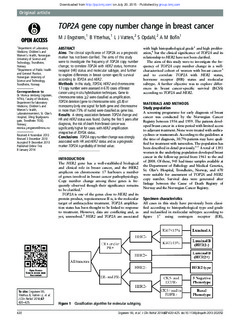TOP2A gene copy number change in breast cancer
| dc.contributor.author | Engstrøm, Monica J | |
| dc.contributor.author | Ytterhus, Borgny | |
| dc.contributor.author | Vatten, Lars Johan | |
| dc.contributor.author | Opdahl, Signe | |
| dc.contributor.author | Bofin, Anna M. | |
| dc.date.accessioned | 2015-08-27T10:21:44Z | |
| dc.date.accessioned | 2015-08-31T07:54:36Z | |
| dc.date.available | 2015-08-27T10:21:44Z | |
| dc.date.available | 2015-08-31T07:54:36Z | |
| dc.date.issued | 2014 | |
| dc.identifier.citation | Journal of Clinical Pathology 2014, 67(5):420-425 | nb_NO |
| dc.identifier.issn | 0021-9746 | |
| dc.identifier.uri | http://hdl.handle.net/11250/298241 | |
| dc.description | - Published article (CC BY-NC 3.0) | nb_NO |
| dc.description.abstract | Aims The clinical significance of TOP2A as a prognostic marker has not been clarified. The aims of this study were to investigate the frequency of TOP2A copy number change; to correlate TOP2A with HER2 status, hormone receptor (HR) status and molecular subtype, and further to explore differences in breast cancer-specific survival according to TOP2A and HER2. Methods In this study, TOP2A, HER2 and chromosome 17 copy number were assessed in 670 cases of breast cancer using in situ hybridisation techniques. Gene to chromosome ratios ≥2 were classified as amplification. TOP2A deletion (gene to chromosome ratio ≤0.8) or monosomy (only one signal for both gene and chromosome in more than 75% of nuclei) were classified as gene loss. Results A strong association between TOP2A change and HR and HER2 status was found. During the first 5 years after diagnosis, the risk of death from breast cancer was significantly higher for cases with HER2 amplification irrespective of TOP2A status. Conclusions TOP2A copy number change was strongly associated with HR and HER2 status and as a prognostic marker TOP2A is probably of limited value. | nb_NO |
| dc.language.iso | eng | nb_NO |
| dc.publisher | BMJ Publishing Group | nb_NO |
| dc.rights | This is an Open Access article distributed in accordance with the Creative Commons Attribution Non Commercial (CC BY-NC 3.0) license, which permits others to distribute, remix, adapt, build upon this work non-commercially, and license their derivative works on different terms, provided the original work is properly cited and the use is non-commercial. | |
| dc.rights.uri | http://creativecommons.org/licenses/by-nc/3.0/ | |
| dc.title | TOP2A gene copy number change in breast cancer | nb_NO |
| dc.type | Peer reviewed | en_GB |
| dc.type | Journal article | nb_NO |
| dc.date.updated | 2015-08-27T10:21:44Z | |
| dc.rights.holder | Published by the BMJ Publishing Group Limited (CC BY-NC 3.0) | |
| dc.source.pagenumber | 420-425 | nb_NO |
| dc.source.volume | 67 | nb_NO |
| dc.source.journal | Journal of Clinical Pathology | nb_NO |
| dc.source.issue | 5 | nb_NO |
| dc.identifier.doi | 10.1136/jclinpath-2013-202052 | |
| dc.identifier.cristin | 1088302 | |
| dc.description.localcode | This is an Open Access article distributed in accordance with the Creative Commons Attribution Non Commercial (CC BY-NC 3.0) license, which permits others to distribute, remix, adapt, build upon this work non-commercially, and license their derivative works on different terms, provided the original work is properly cited and the use is non-commercial. | nb_NO |
Tilhørende fil(er)
Denne innførselen finnes i følgende samling(er)
Med mindre annet er angitt, så er denne innførselen lisensiert som This is an Open Access article distributed in accordance with the Creative Commons Attribution Non Commercial (CC BY-NC 3.0) license, which permits others to distribute, remix, adapt, build upon this work non-commercially, and license their derivative works on different terms, provided the original work is properly cited and the use is non-commercial.

